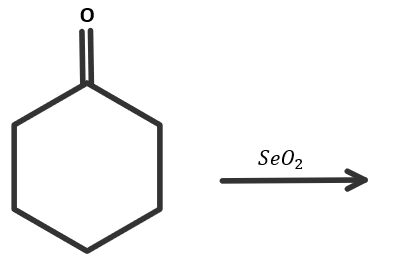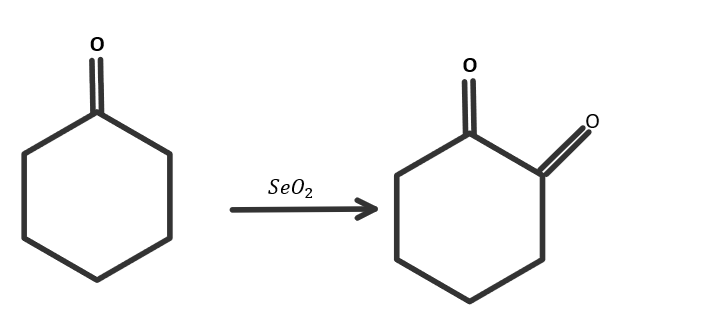
When cyclohexanone reacts with selenium dioxide, what product will be formed?

A.Cyclohexane $1,2 - $ dione
B.$1,6 - $ hexanedione
C.Cyclohexane $1,4 - $ dione
D.$2 - $ hydroxy cyclohexan $1 - $ one

Answer
561.3k+ views
Hint: Functional group: In the hydrogen the atoms or groups which are other than carbon and hydrogen, are known as function groups. For example: chloride if chlorine is present in the compound. And if $CO$ is attached then the functional group will be ketone.
Complete step by step solution:
First of all we will talk about the alkanes, alkenes and alkynes.
Alkanes: The compounds which are formed by carbon and hydrogen and have only a single bond between the carbon-carbon atoms, are known as alkanes. For example: The first member of the alkane family is ethane $({H_3}C - C{H_3})$. The general formula of the alkane group is ${C_n}{H_{(2n + 2)}}$.
Alkenes: The compounds which are formed by carbon and hydrogen and have at least one double bond along with a single bond between the carbon-carbon atoms, are known as alkenes. For example: The first member of the alkene family is ethene $({H_2}C = C{H_2})$. The general formula of the alkene group is ${C_n}{H_{2n}}$.
Alkynes: The compounds which are formed by carbon and hydrogen and have at least one triple bond along with a single bond between the carbon-carbon atoms, are known as alkynes. For example: The first member of the alkyne family is ethyne $(HC \equiv CH)$. The general formula of the alkyne group is ${C_n}{H_{(2n - 2)}}$.
Functional group: In hydrogen the atoms or groups which are other than carbon and hydrogen, are known as function groups. For example: chloride if chlorine is present in the compound.
When cyclohexanone reacts with selenium dioxide, then the product is as Cyclohexane $1,2 - $ dione. Because the cyclohexane ring will be the same and one more ketone group will be attached to the parent chain so the IUPAC name of the product will be Cyclohexane $1,2 - $ dione. The reaction is as follows:

So the correct answer is option C.
Note: Suffix to some functional group are as: for carboxylic acid suffix used is –oic acid, for alcohols suffix used is alkyl alcohol. For example: if an alcohol group is present in methane then the IUPAC name of the compound will be methyl alcohol.
Complete step by step solution:
First of all we will talk about the alkanes, alkenes and alkynes.
Alkanes: The compounds which are formed by carbon and hydrogen and have only a single bond between the carbon-carbon atoms, are known as alkanes. For example: The first member of the alkane family is ethane $({H_3}C - C{H_3})$. The general formula of the alkane group is ${C_n}{H_{(2n + 2)}}$.
Alkenes: The compounds which are formed by carbon and hydrogen and have at least one double bond along with a single bond between the carbon-carbon atoms, are known as alkenes. For example: The first member of the alkene family is ethene $({H_2}C = C{H_2})$. The general formula of the alkene group is ${C_n}{H_{2n}}$.
Alkynes: The compounds which are formed by carbon and hydrogen and have at least one triple bond along with a single bond between the carbon-carbon atoms, are known as alkynes. For example: The first member of the alkyne family is ethyne $(HC \equiv CH)$. The general formula of the alkyne group is ${C_n}{H_{(2n - 2)}}$.
| Number of carbon atom in alkane | Name of the parent chain |
| One | Methane |
| Two | Ethane |
| Three | Propane |
| Four | Butane |
| Five | Pentane |
| Six | Hexane |
| Seven | Heptane |
Functional group: In hydrogen the atoms or groups which are other than carbon and hydrogen, are known as function groups. For example: chloride if chlorine is present in the compound.
When cyclohexanone reacts with selenium dioxide, then the product is as Cyclohexane $1,2 - $ dione. Because the cyclohexane ring will be the same and one more ketone group will be attached to the parent chain so the IUPAC name of the product will be Cyclohexane $1,2 - $ dione. The reaction is as follows:

So the correct answer is option C.
Note: Suffix to some functional group are as: for carboxylic acid suffix used is –oic acid, for alcohols suffix used is alkyl alcohol. For example: if an alcohol group is present in methane then the IUPAC name of the compound will be methyl alcohol.
Recently Updated Pages
Why are manures considered better than fertilizers class 11 biology CBSE

Find the coordinates of the midpoint of the line segment class 11 maths CBSE

Distinguish between static friction limiting friction class 11 physics CBSE

The Chairman of the constituent Assembly was A Jawaharlal class 11 social science CBSE

The first National Commission on Labour NCL submitted class 11 social science CBSE

Number of all subshell of n + l 7 is A 4 B 5 C 6 D class 11 chemistry CBSE

Trending doubts
What is meant by exothermic and endothermic reactions class 11 chemistry CBSE

10 examples of friction in our daily life

One Metric ton is equal to kg A 10000 B 1000 C 100 class 11 physics CBSE

1 Quintal is equal to a 110 kg b 10 kg c 100kg d 1000 class 11 physics CBSE

Difference Between Prokaryotic Cells and Eukaryotic Cells

What are Quantum numbers Explain the quantum number class 11 chemistry CBSE




